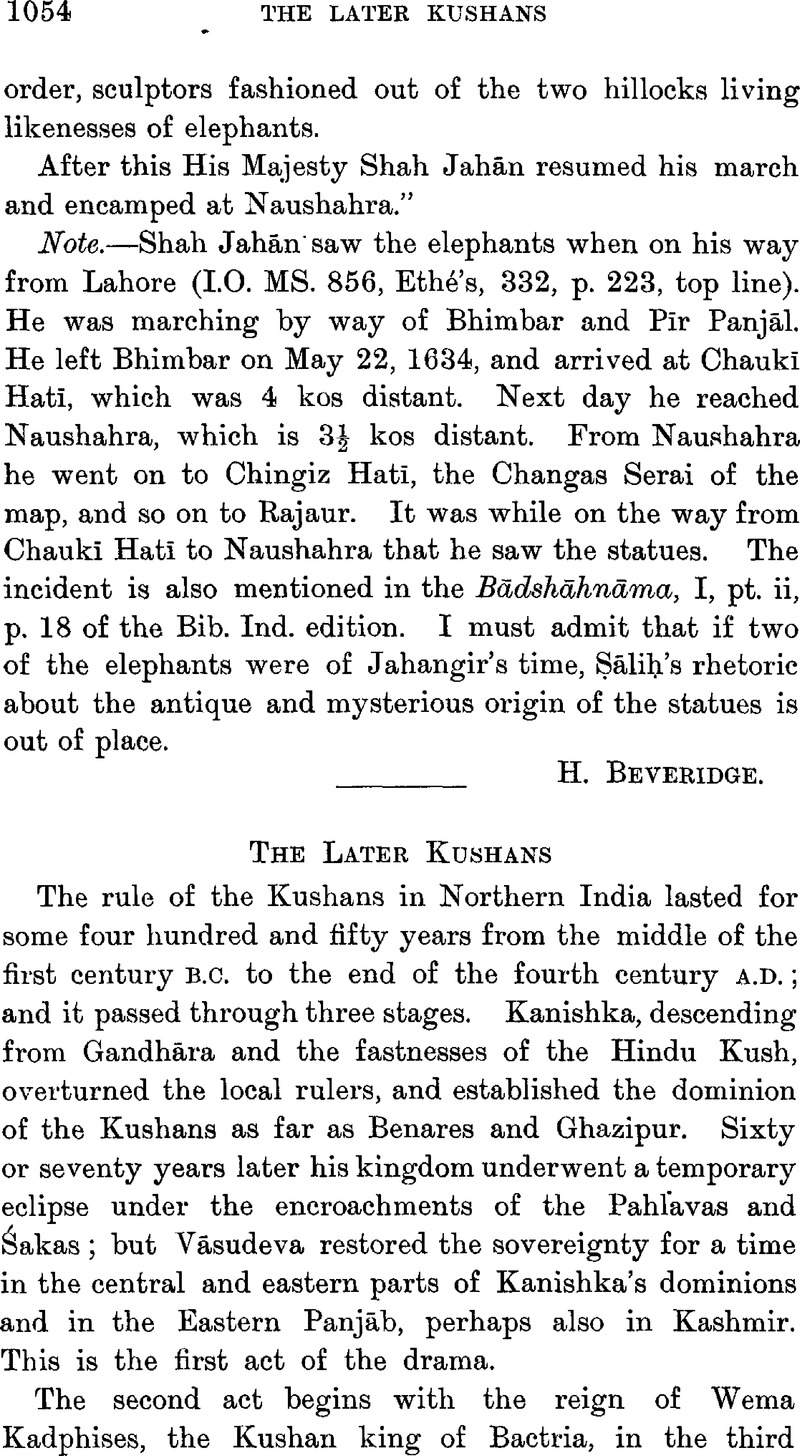
page 1056 note 1 For the identification of Sāgala, Śākala, with Siālkoṭ see Dr. Fleet's article in the Acts of the Oriental Congress of Algiers, 1905, Indian Section, p. 164 ff.
page 1056 note 2 Ptolemy's Geography, vii, 42–55Google Scholar; McCrindle's trans., pp. 104–36. McCrindle (p. 109) says: “In the time of Ptolemy the kingdom of Kashmir was the most powerful state in all India. The dominions subject to its sceptre reached as far south as the range of the Vindhyas, and embraced, together with the extensive mountain region wherein the great rivers of the Panjāb had their sources, a great part of the Panjāb itself, the courses of the Jamnā and the Upper Ganges. So much we learn from Ptolemy's description.” For this remark see also Ind. Ant., vol. 13, p. 346Google Scholar, where McCrindle's translation of Ptolemy was first published.
page 1057 note 1 JRAS. 1912, p. 678.Google Scholar
page 1057 note 2 T'oung pao, 1905, p. 520.Google Scholar
page 1057 note 3 Ibid., p. 538.
page 1057 note 4 Ibid., p. 551.
page 1057 note 5 Almost all Sinologists are agreed that in the centuries immediately before and after the beginning of the Christian era Ki-pin meant Kashmīr; in the seventh century of our era it ordinarily, “although not invariably, meant Kapiśa, or North-Eastern Afghanistan” (Smith, V., Early History, p. 235, n. 1Google Scholar). Chavannes in his translation of the Wei Lio, which I have quoted above, makes it Kashmīr. But Dr. Herrmann, the latest writer on the subject, holds that it was Gāndhāra. He has not given us his reasons, but it is just possible that in the Wei Lio Gāndhāra may be meant.
page 1058 note 1 JRAS. 1912, p. 682.Google Scholar
page 1059 note 1 Rapson, , “Indian Coins” (Grundriss), § 74, p. 19.Google Scholar
page 1059 note 2 Fleet, , “The Question of Kanishka”: JRAS. 1913, p. 95 ff.Google Scholar
page 1059 note 3 Schiefner, , Tāranātha, pp. 89–90Google Scholar. It seems hopeless to construct any precise chronological system out of Tāranātha's.
page 1061 note 1 Rapson, , “Indian Coins” (Grundriss), § 74, p. 19.Google Scholar
page 1061 note 2 Rawlinson, , Seventh Oriental Monarchy, pp. 108–9Google Scholar; Gibbon, c. xii (Smith's ed., vol. ii, pp. 54–5).
page 1061 note 3 Rawlinson, , op. cit., pp. 140–1.Google Scholar
page 1061 note 4 Vopisc. Vit. Aurel., c. 29 (Script. Hist. Aug.): “pallium breve purpureum lanestre, ad quod cum matronæ atque ipse Aurelianus jungerent purpuras suas, cineris specie decolorari videbantur ceterse, divini comparatione fulgoris. Hoc munus rex Persarum ab Indis interioribus sumpbum Aureliano dedisse perhibetur, scribens: sume purpuram, qualis apud noa est.” The colouring of the shawl and the woollen texture show that it came from Kashmīr, a country which even in the time of the Early Han, i.e. in the first century b.c., was reported to be famous for its artistic handiwork. The dyes of Kashmir were unrivalled until quite late in the nineteenth century; so a shawlmerchant, a Frenchman, once informed the present writer.
page 1062 note 1 Rapson, , “Indian Coins” (Grundriss), §§ 74, 75, p. 19Google Scholar; Rawlinson, , Seventh Oriental Monarchy, p. 141, n. 1.Google Scholar
page 1062 note 2 Rawlinson, , op. cit., pp. 176–7Google Scholar; Am. Mar. xix, c. 7; Gibbon, c. xix (vol. ii, p. 408).
page 1062 note 3 The Devaputra was rich in elephants—an epithet more applicable to the ruler of the Panjāb than to the kings of Kashmīr and Kabul. When the Kushan empire broke up it would appear from Samudragupta's Allahabad inscription, which mentions the Devaputras, Shāhis, and Shāhānushāhis among the rulers who did respectful service to him, as if each king had appropriated to himself one of the former imperial titles. Devaputra in that case became the peculiar title of the sovereign of North-Western India, while we know that the Turki rulers of Gandhāra appropriated to themselves the title of Shāhi.
page 1063 note 1 Rapson, , “Indian Coins” (Grundriss), §§ 50, 60.Google Scholar
page 1063 note 2 Smith, V., JRAS. 1897, p. 887.Google Scholar
page 1063 note 3 Ibid., p. 889. For Sāgala = Siālkoṭ, see note 1 on p. 1054 above.
page 1063 note 4 Fleet, CII., vol. iii, The Gupta Inscriptions, p. 14.Google Scholar
page 1063 note 5 Possibly, as I have said, the Ki-pin of the Wei Lio may be Gandhara, and the Eastern Panjāb and Kashmīr may have formed a single state.
page 1063 note 6 Legge, , “Record of Buddhistic Kingdoms” (Travels of Fa Hian), p. 42.Google Scholar
page 1064 note 1 Chavannes, , T'oung-pao, sér. ii, vol. viii, No. 2, p. 188 (pp. 41–2, n. 2, of reprint).Google Scholar
page 1064 note 2 Other variations are Hephthalites and Nepthalites. Cidaritae is another name.